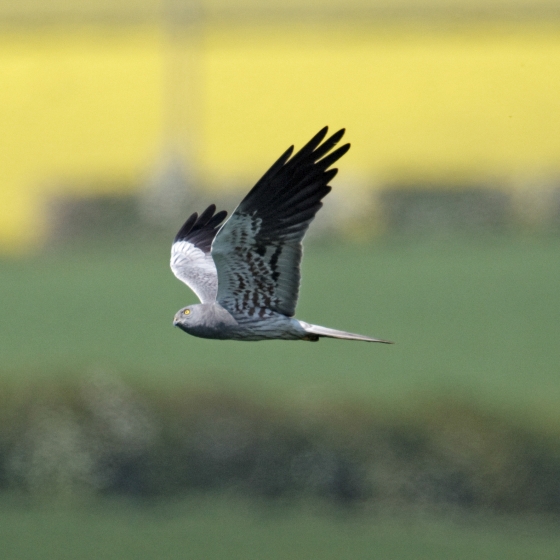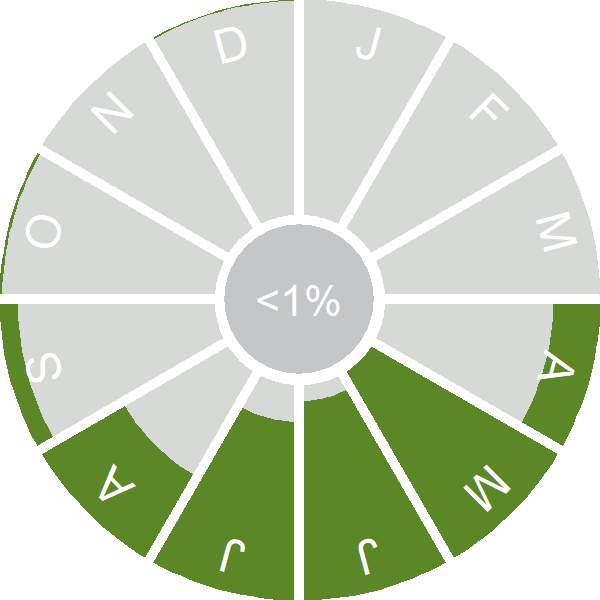Montagu's Harrier

Introduction
Arguably our rarest breeding diurnal bird of prey, Montagu's Harrier is an exclusively summer visitor and one associated with drier habitats than our other breeding harrier species.
Britain is on the north-west fringe of the Montagu's Harrier's European breeding range, holding just a very small number of breeding pairs annually. This wider distribution suggests that we should be able to support more pairs, implying that lack of suitable habitat or other factors may be limiting.
While there are some areas within Britain that have held pairs over many years – for example the open arable farmland of Wiltshire and neighbouring counties – atlas data suggest a more fluent pattern of settlement.

Key Stats
Identification
ID Videos
This section features BTO training videos headlining this species, or featuring it as a potential confusion species.
Harriers
Songs and Calls
Call:
Flight call:
Status and Trends
Conservation Status
Population Change
The Montagu's Harrier is an extremely rare breeding species in the UK and the population has decreased strongly over the 25 years to 2019; in 2019 only two pairs were present and only one pair bred (Eaton et al. 2021). Breeding numbers have previously fluctuated: After having peaked at around 30 pairs in the mid-1950s they decreased and there were no pairs in 1974, before numbers improved again to a maximum of 13 pairs in the late 2000s (Balmer et al. 2013).
Distribution
During Bird Atlas 2007–11
Occupied 10-km squares in UK
or view it on Bird Atlas Mapstore.
European Distribution Map
Distribution Change
Change in occupied 10-km squares in the UK
or view it on Bird Atlas Mapstore.
Seasonality
Montagu's Harrier is an increasingly rare summer visitor, arriving from April onwards.
Weekly pattern of occurrence
The graph shows when the species is present in the UK, with taller bars indicating a higher likelihood of encountering the species in appropriate regions and habitats.

Movement
Britain & Ireland movement
Foreign locations of birds ringed or recovered in Britain & Ireland
Dots show the foreign destinations of birds ringed in Britain & Ireland, and the origins of birds ringed overseas that were subsequently recaptured, resighted or found dead in Britain & Ireland. Dot colours indicate the time of year that the species was present at the location.
- Winter (Nov-Feb)
- Spring (Mar-Apr)
- Summer (May-Jul)
- Autumn (Aug-Oct)

European movements
EuroBirdPortal uses birdwatcher's records, such as those logged in BirdTrack to map the flows of birds as they arrive and depart Europe. See maps for this species here.
The Eurasian-African Migration Atlas shows movements of individual birds ringed or recovered in Europe. See maps for this species here.
Biology
Productivity and Nesting
Nesting timing
Egg measurements
Clutch Size
Survival and Longevity
Survival is shown as the proportion of birds surviving from one year to the next and is derived from bird ringing data. It can also be used to estimate how long birds typically live.
View number ringed each year in the Online Ringing Report.
lifespan
Survival of adults
Biometrics
Wing length and body weights are from live birds (source).
Ring Size
Classification, names and codes
Classification and Codes
- Order: Accipitriformes
- Family: Accipitridae
- Scientific name: Circus pygargus
- Authority: Linnaeus, 1758
- BTO 2-letter code: MO
- BTO 5-letter code: MONHA
- Euring code number: 2630
Alternate species names
- Catalan: arpella cendrosa
- Czech: moták lužní
- Danish: Hedehøg
- Dutch: Grauwe Kiekendief
- Estonian: soo-loorkull
- Finnish: niittysuohaukka
- French: Busard cendré
- German: Wiesenweihe
- Hungarian: hamvas rétihéja
- Icelandic: Gráheiðir
- Irish: Cromán Liath
- Italian: Albanella minore
- Latvian: plavu lija
- Lithuanian: pievine linge
- Norwegian: Enghauk
- Polish: blotniak lakowy
- Portuguese: águia-caçadeira
- Slovak: kana popolavá
- Slovenian: mocvirski lunj
- Spanish: Aguilucho cenizo
- Swedish: ängshök
- Welsh: Boda Montagu
- English folkname(s): Ash-coloured Falcon
Research
Causes of Change and Solutions
Causes of change
Pesticides and a drought in the Sahel which began in 1968 may have driven the declines in the late 1950s and 1960s (Clarke 1996). Numbers have never recovered fully and, with Montagu's Harriers often nesting in agricultural crops, local action and monitoring can be important to support and protect nests and young (Clarke 1996, Balmer et al. 2013).

